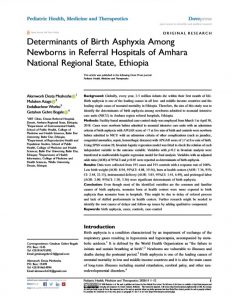
Background
Globally, every year, 2.5 million infants die within their first month of life. Birth asphyxia is one of the leading causes in all low- and middle-income countries and the leading single cause of neonatal mortality in Ethiopia. Therefore, the aim of this study was to identify the determinants of birth asphyxia among newborns admitted to neonatal intensive care units (NICU) in Amhara region referral hospitals, Ethiopia.
Methods
Facility-based unmatched case-control study was employed from March 1 to April 30, 2018. Cases were newborn babies admitted to neonatal intensive care units with an admission criteria of birth asphyxia with APGAR score of <7 at five min of birth and controls were newborn babies admitted to NICU with an admission criteria of other complications (such as jaundice, congenital anomalies, sepsis, hemorrhagic diseases) with APGAR score of ≥7atfive min of birth. Using SPSS version 20, bivariate logistic regression model was fitted to check the relation of each independent variable to the outcome variable. Variables with p<0.2 in bivariate analysis were transferred to multivariable logistic regression model for final analysis. Variables with an adjusted odds ratio (AOR) of 95%CI and p<0.05 were reported as determinants of birth asphyxia.
Results
Data were collected from 193 cases and 193 controls with a response rate of 100%. Low birth weight (AOR: 8.94, 95%CI: 4.08, 19.56), born at health centers (AOR: 7.36, 95% CI: 2.44, 22.13), instrumental delivery (AOR: 3.03, 95%CI: 1.41, 6.49), and prolonged labor (AOR: 2.00, 95%CI: 1.20, 3.36) were significant determinants of birth asphyxia.
Conclusion
Even though most of the identified variables are the common and familiar causes of birth asphyxia, neonates born at health centers were more exposed to birth asphyxia than neonates born in hospitals. This might be due to delay of referral process and lack of skilled professionals in health centers. Further research might be needed to identify the root causes of delays and follow-up issues by adding qualitative component.